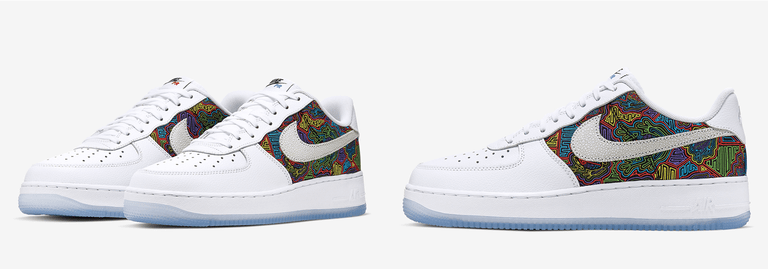Nike Shoe Design Stolen from Guna Indigenous Women and Marketed as Puerto Rican
Just weeks before the new “Puerto Rican-themed” Nike Air Force 1 shoes were to be released, Nike cancelled the whole thing. The so-called Puerto Rican design was in fact an outright copy of a traditional mola design unique to the Guna, an Indigenous tribe from Guna Yala in Panama and from parts of Colombia. The Guna people quickly made it known that the artwork belonged to them and that the American multinational corporation had used it without permission.

The design included a coqui frog, Puerto Rico’s national animal, with a colourful border. It was originally reported to be inspired by the street art found in the American territory of Puerto Rico, and the release was intended to coincide with the Annual National Puerto Rican Day Parade that occurs in New York City at the beginning of every June. However, the distinct colour combinations and zigzag borders are a signature pattern that belongs to the Indigenous women of the Guna tribe. Nike had not only made the grave mistake of pirating an Indigenous design, but had also falsely promoted it as being Puerto Rican. Upon cancelling the shoe, Nike issued an apology:
“We apologize for the inaccurate representation of the design origin for the Nike Air Force 1 ‘Puerto Rico’ 2019. As a result, this product will no longer be available.”
Nike
The design comes from mola
Mola is the Guna word for clothing. Molas, which are primarily used for Guna women’s traditional blouses, are cloth panels made with layers of fabric. Guna women have been making molas for many centuries. The ability to make an impressive mola is a symbol of status among the women, with quality determined by factors such as “the number of layers, fineness of stitching, evenness and width of cut-outs, addition of details, … the general artistic design, and color combination”. Before the introduction of cloth by European Settlers, Guna women traditionally painted their upper bodies with red from annatto, yellow from turmeric root, and indigo from jagua juice; that is why red, yellow, and indigo are the most prominent colours in mola designs. The geometric patterns are inspired by nature and are representative of “animals, fish, flowers, and daily life”.
With the growing commodification of Indigenous artwork, Guna women have expanded their artistry to “tourist molas”. These types of molas are made strictly for trade and are never intended for a blouse, since most tourists enjoy them as decorative pieces and the Guna do not want tourists wearing their traditional clothing. The Guna are sensitive to issues associated with the commodification of their heritage, and in the interest of protecting their cultural identity, they prohibit the sale of molas outside of Panama and Colombia.
“The mola is like a flag for the Guna. There is really a cultural identity that is articulated around the mola. It is a very strong element of identity.”
Monica Martinez, Professor of Social Anthropology at Barcelona University, who has studied the Guna for 20 years
The mola is protected under Panamanian law
In 1984, as the mola design became increasingly popular, the Guna women mobilized and the Panamanian government passed Law No. 26, prohibiting the importation of counterfeit molas or any garment that imitated or resembled a mola. Then, in 2000, Law No. 20 (also known as Panama’s Indigenous Intellectual Property Law) was passed. Protection under Law No. 20 requires that the subject matter must be collectively owned, originally from an Indigenous source, authentically Indigenous, and commercially viable. The aim of Law No. 20 is to protect Indigenous IP rights as both cultural heritage and a source of income for the Guna people.
Protection under the law is not automatic; it requires registration. The Guna tribe registered its collective right “over the mola and all its commercial uses and applications” in 2002. Genuine molas are identified by the Kalus Tukbis (Galu Dugbis) trademark, indicating authenticity and ownership by the Guna tribe. Non-Guna people must obtain a licence from the Guna to manufacture molas, and they must inform all prospective purchasers that the mola was made by non-Guna people with Guna consent.
Aresio Valiente Lopez, a Guna lawyer and one of the drafters of Law No. 20, represents the Guna in their complaint against Nike. Lopez has stated publicly that the Guna people are not only seeking the withdrawal of the shoe, but they are also seeking compensation for the damage that the stolen design has done to their cultural identity.
Indigenous Peoples demand better IP law and policy.
Panama’s Indigenous IP Law certainly conveys a progressive approach to protecting Indigenous cultural heritage and identity and promoting Indigenous economies. Law No. 20, however, remains broad, and fails to give adequate or necessary authority to individual Guna women, from whom the molas come. While the Guna People’s collective and perpetual rights to the mola address their concern for maintaining authenticity and commercial value, the system for enforcing these rights is not flexible enough to address the interests of the Guna women. It has thus been suggested that Law No. 20 should be amended to include a “fair use exception for Kuna women”.
The Guna people have fought hard for the legal protections they have today. However, the Guna and many other Indigenous peoples worldwide still mostly rely on their own grassroots initiatives to assert their rights over their cultural identities. Cases of multinational companies pirating Indigenous designs have only multiplied, and IP law and policy on an international level has yet to address this. Time and time again, Indigenous peoples have asserted the inherent ties between their cultural expressions, traditional knowledge, and Indigenous identities. Until international legal systems take proactive steps to protect Indigenous peoples’ rights, multinational corporations will continue to take advantage of existing gaps in IP legislation at the expense of Indigenous peoples.






